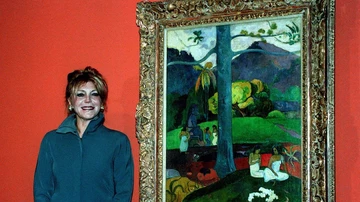After 9:20 p.m. on Monday, the mythical Mata Mua, by Paul Gauguin, returned between strong security measures to the Thyssen museum. A convoy flanked by several National Police cars moved the painting from a bunker in Andorra to the main entrance of the facilities in the center of Madrid.
The painting, from the end of the 19th century and framed within the current of the Postimpressionismis considered the jewel in the crown of the Carmen Cervera collection.
In search of artistic inspiration, the French painter Paul Gauguin undertook a trip to Tahiti in 1891. He wanted to live apart from Western civilization, having contact with primitive peoples. “I want to go with the savages,” said the artist at the time.
In December 1892, Gauguin gave life to the emblematic Mata Mua (Once upon a time) trying to reflect that ‘the lost paradise’ that he was looking for did not really exist.
The work is an oil on canvas 91 centimeters high and 69 wide that represents a landscape of Tahiti. In the center of the composition, a tree monopolizes much of the protagonism. Furthermore, Gauguin depicts two women in the foreground: one plays the flute and the other listens. Behind it is a statue of the moon goddess around which several women dressed in blue and white dance. In the background, a mountain of pink colors stands out above the vegetation.
The first time the painting was exhibited was in 1893 and after Paul Gauguin’s deathIn May 1903, the work went through different auctions and collections.
In 1984, Baron Hans Heinrich von Thyssen-Bornemisza bought the painting half with Ortiz Palatino, a Bolivian collector, for almost 4 million dollars.
Both reached an agreement that each of them would have the painting for two and a half years and, five years later, one would have to buy the other’s part, or put the painting up for auction. Palatino rejected Baron Thyssen’s offer, who finally acquired the work in May 1989 for more than 24 million dollars.
In the summer of 1993, months after the Thyssen museum opened its doors in Madrid, the baron sold 775 pieces of art to the Spanish statebut put aside the Mata Mua, which is part of the Carmen Cervera collection.
Last Wednesday, two days after the Mata Mua returned to Spain, Carmen Cervera and the Minister of Culture, Miquel Iceta, staged a agreement that ended a decade of complicated negotiations and for which the Baroness will receive 6.5 million euros from the State for 15 years for the rental of her works.
The return to Spain of Mata Mua, the star of Carmen Cervera’s collection, has been key for the cadres to finally stay in our country.
It was in full confinement, in June 2020, when the Mata Mua left the Thyssen museum for Andorra, thus opening one of the most serious crises of the negotiations between the Government and Carmen Cervera that have finally come to fruition.

Source: Lasexta
Ricardo is a renowned author and journalist, known for his exceptional writing on top-news stories. He currently works as a writer at the 247 News Agency, where he is known for his ability to deliver breaking news and insightful analysis on the most pressing issues of the day.











